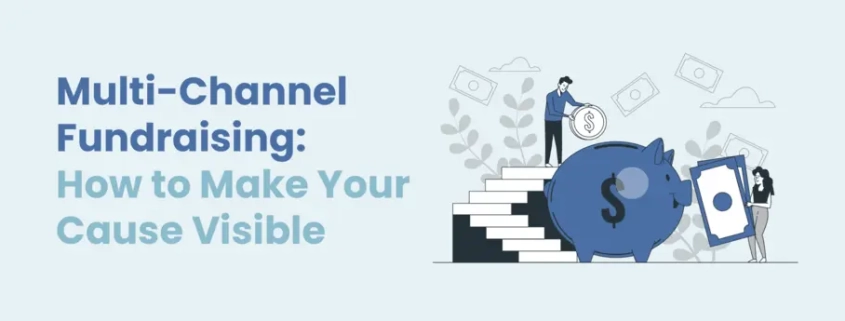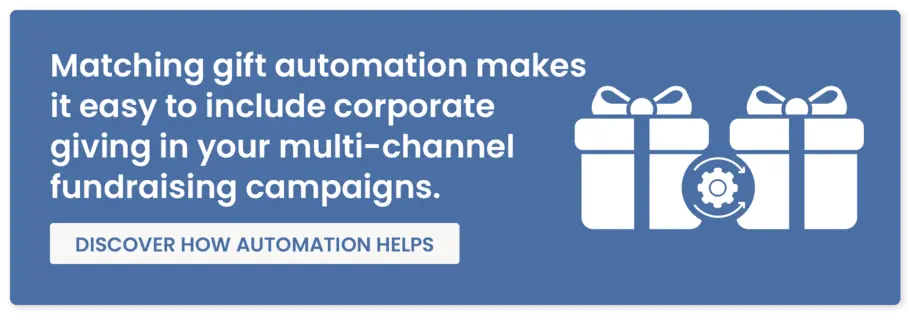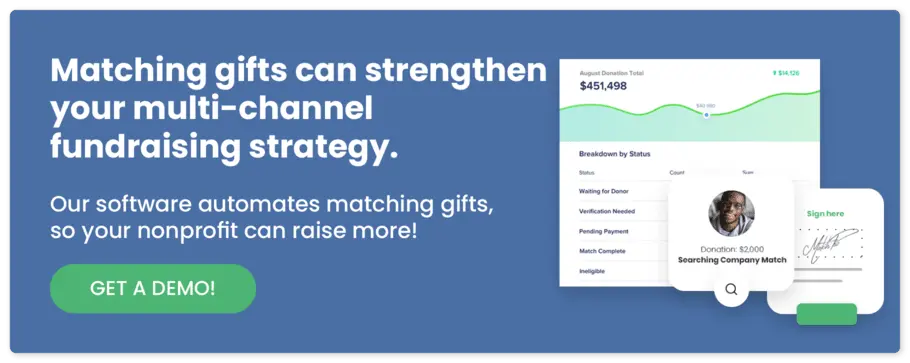Multi-Channel Fundraising: How to Make Your Cause Visible
Our world is inundated with information. While great for putting infinite knowledge at our fingertips, nonprofits are challenged to cut through the noise.
Multi-channel fundraising, an approach that leverages a variety of communication and donation channels, is a key strategy that empowers modern fundraisers to make their voices heard. Think about it this way: with each additional channel you use to communicate your messages, you increase the number of people you expose to your mission. Even better, integrating matching gifts into messages across all channels adds a compelling incentive, encouraging donors to maximize their contributions.
To elevate your campaigns, we’ll explore everything your nonprofit needs to know about multi-channel fundraising, including key channels you won’t want to overlook and strategies that will enhance your outreach:
- What Is Multi-Channel Fundraising?
- The Importance of Multi-Channel Donor Outreach
- Different Channels to Include in Your Strategy
- How to Launch a Foolproof Multi-Channel Fundraiser
Getting your message in front of donors is essential for securing funds and ensuring your work gains the traction it needs. Now, let’s dive into the basics of multi-channel fundraising.
What Is Multi-Channel Fundraising?
Multi-channel fundraising is the strategic approach a nonprofit uses to raise funds through various communication and donation channels. This method involves reaching out to donors across multiple platforms to maximize visibility for fundraising opportunities. A holistic multi-channel fundraising strategy incorporates both online and offline methods, such as email, social media, corporate partnerships, and direct mail.
By leveraging a diverse mix of communication methods, nonprofits can widen their reach, meeting individuals where they’re most active.
The Importance of Multi-Channel Donor Outreach
With so many platforms available, multi-channel fundraising has become an accessible and essential nonprofit strategy. Not only does this approach align with the communication preferences of a diverse donor base, but it also amplifies your fundraisers’ reach.
Here’s a rundown of some of the key benefits of multi-channel donor outreach:
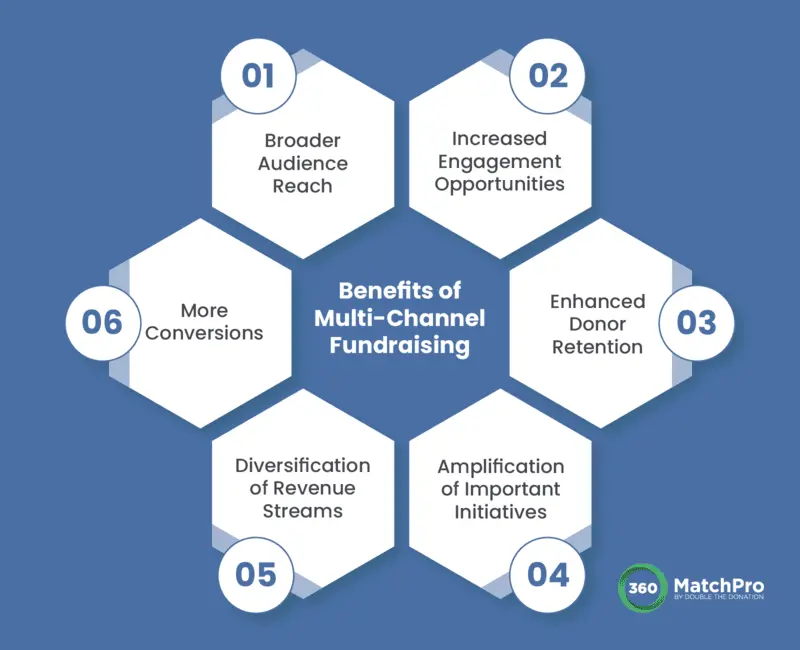
- Broader Audience Reach: Connecting with donors across several channels allows organizations to inspire different demographics, including different age groups, interests, and behaviors. By using a mix of digital and traditional platforms, your nonprofit can reach potential donors beyond your usual network.
- Increased Engagement Opportunities: You’ll have numerous touchpoints for engaging with donors, from social media interactions to email campaigns. Each channel provides unique engagement opportunities, cultivating deeper relationships.
- Enhanced Donor Retention: When you’re present across multiple channels, you can stay top-of-mind with donors. Regular, varied communication through these channels helps build lasting donor relationships, leading to increased loyalty.
- Amplification of Important Initiatives: Multi-channel fundraising is particularly effective in promoting big initiatives like matching gifts. By highlighting matching gift opportunities in particular across various platforms, your nonprofit can educate and encourage more donors to participate, potentially doubling fundraising revenue.
- Diversification of Revenue Streams: Using multiple channels for fundraising mitigates the risk of over-reliance on a single source of donations. It opens up various avenues for revenue, ensuring a more stable funding base.
- More Conversions: Using several fundraising channels naturally increases the number of people who see your messages. In turn, you can inspire more people to give. In fact, leveraging multiple channels for a campaign can lead to a 204% conversion increase. Researchers predict this is because some parts of campaigns are better suited for certain mediums than others.
From amplifying key initiatives to expanding to new demographics, multi-channel fundraising is helpful for any nonprofit seeking to maximize its impact.
Different Channels to Include in Your Strategy
With each additional channel, you increase the number of individuals who will encounter your message. However, don’t spread yourself too thin by using every channel possible. Instead, you need to choose platforms that have the highest potential for viewership to maximize your fundraisers’ visibility.
That way, even if your latest fundraising email is delivered to a donor’s spam folder, they’ll have another chance to view it elsewhere, like social media! Let’s explore some of the most common channels nonprofits leverage to promote fundraisers.
Email Fundraising
According to our nonprofit fundraising research, 48% of donors say regular email communications are the channel that’s most likely to inspire repeat donations. What’s more, email marketing campaigns generate approximately 28% of all online nonprofit revenue. That makes it a fundamental component of your multi-channel fundraising strategy.
It’s one of the most cost-effective, direct ways to connect with donors. To drive fundraising revenue through this channel, you should:
- Personalize your outreach. Email enables highly personalized communication. Segment your email list based on donor interests, giving history, demographic information, and engagement levels. Strategic segmentation enables targeted messaging that resonates with different groups, increasing each fundraising appeal’s relevance.
- Create compelling content. Craft emotional stories that emphasize the impact of donations and resonate with readers, and highlight upcoming events and matching gift opportunities. Be sure to include easy-to-use donation links, so donors can conveniently contribute. Then, top it all off with an engaging subject line to encourage clicks.
- Leverage scheduling. Email allows for timely communication that can be sent quickly in response to current events or urgent funding needs. Alternatively, you can schedule your emails to be sent later for important dates like a cause awareness day or GivingTuesday. This flexibility is vital for capitalizing on moments when donor interest is highest.
You can also create a cohesive multi-channel experience by directing readers to your organization’s social media pages, website, or upcoming events.
One of the best parts of email campaigns is that they’re easily trackable. Pay attention to metrics such as open rates, click-through rates, and conversion rates to gauge the effectiveness of each email. That way, you can refine your strategies and continuously improve fundraising communications.
Corporate Partnerships
Partnerships between companies and nonprofits are essential to a cohesive multi-channel fundraising strategy. The idea of these partnerships is to be mutually beneficial, leading to a strengthened reputation for companies and more support for nonprofits.
These collaborations can take multiple forms such as:
- Cause marketing: Through this form of corporate philanthropy, a company will promote your cause, such as by contributing a portion of a product’s proceeds to your organization. This strategy boosts fundraising by leveraging the company’s brand and customer base.
- Corporate donations: These are direct financial or in-kind contributions from a company to your nonprofit. These donations provide crucial funding for projects and various operational needs. The company may also provide in-kind gifts such as a venue for an upcoming fundraising event.
- Corporate volunteer grants: Corporate volunteerism involves companies encouraging employees to volunteer time and skills to nonprofits. Often, the company will offer monetary donations based on volunteer hours, providing hands-on assistance and financial support.
- Matching donation challenges: Some companies will pledge to match a portion or all of the donations made to your nonprofit during a specific time period. Known as a matching donation challenge, this is a great way to amplify fundraising impact.
- Matching gifts: Employee matching gifts are a form of employee giving where companies match their employees’ donations to eligible nonprofits, doubling charitable impact. Your corporate partner can encourage employees to donate to your organization specifically to show their commitment to your cause. If you’re curious about this donation channel, watch this video to learn more:
Google Ads
For nonprofits leveraging paid advertising, the return on ad spend is highest for search ads, generating $2.75 for every dollar spent. That makes Google Ads an incredibly valuable platform for nonprofits. To make this channel even more enticing, eligible nonprofits can leverage this tool for free.
Through the Google Ad Grant program, approved organizations receive up to $10,000 to spend on Google Ads every month. This money can be spent promoting your website’s most important content and placing it at the top of search engine results pages (SERPs) for mission-related keywords. For example, here’s an example of a SERP for the search term “donate to stop deforestation:”
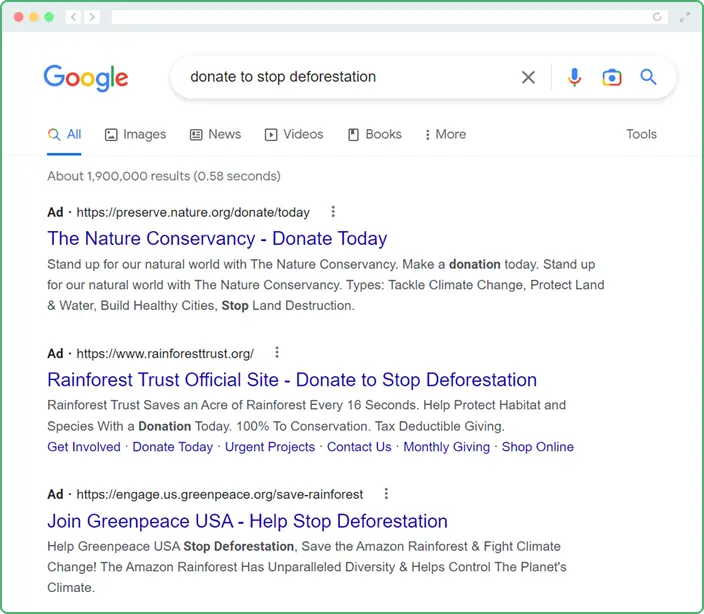
Here’s how the Google Ad Grant is most helpful in the context of multi-channel fundraising:
- Promote different fundraising initiatives. By using targeted ads, your nonprofit can direct potential donors to your online donation form, event registration page, Ways to Give page, or another campaign page. This helps convert interest into action since people who click the ads are often already interested in the cause.
- Target different users. Google Ads allows nonprofits to target ads to specific groups of people based on factors like demographics, interests, search behaviors, and location. This means organizations can tailor their messages to reach individuals most likely to support their cause.
- Increase visibility. With Google Ads, nonprofits can appear at the top of search results when people search for relevant keywords. This can be super helpful since 98% of searchers click a result on page 1 of Google search results. Increasing visibility can help raise awareness among various audiences, including those who are unreachable through other channels. That makes it an effective way to diversify your fundraising efforts and extend your reach.
Even if people don’t click your Google Ads, you can still generate revenue from this channel. In fact, Getting Attention’s Google Ad Grant Impact Report estimates that 35% of all giving sourced from digital ads comes from view-through revenue, which is revenue from donors who saw but didn’t click on an ad. You’ll just need to spend time creating strongly written ads that drive users to a compelling campaign page.
Social Media Fundraising
Social media is an indispensable channel in multi-channel fundraising, offering a variety of platforms to connect with potential donors, engage current supporters, and drive fundraising efforts. Its inherent strength lies in its ability to eliminate geographical barriers, foster community, share compelling narratives, and facilitate instant communication.
Add in fundraising tools like donation buttons, and social media becomes unstoppable. In fact, Nonprofits Source estimates that 55% of people who engage with nonprofits on social media wind up taking action.
Through these platforms, nonprofits can reach diverse audiences that span various age groups, interests, and geographical locations:
- Facebook: Use Facebook to create dedicated fundraising pages where you can share beneficiaries’ stories, post updates, and receive donations through the platform’s integrated donation button. Facebook also enables you to line up fundraising events and supporters to create peer-to-peer campaigns, where they raise funds for your cause.
- Instagram: As a visually driven platform, Instagram is ideal for storytelling through compelling images and videos. Enhance your posts with features like “Swipe Up” links in Stories or donation stickers to direct supporters to your donation page. Also, leverage Instagram Live for real-time Q&A sessions and live fundraising events.
- X (formerly Twitter): Best used for real-time communication, X enables you to share quick messages about your cause, fundraising events, and success stories. Your team can engage in relevant conversations and share the latest news about your work, positioning your nonprofit as a reliable steward of donations.
- TikTok: According to that same Nonprofits Source’s resource, 57% of people who watch nonprofit videos donate, making TikTok a valuable platform for publishing solicitations. Tap into younger audiences by creating short-form video content and tapping into current trends. Through TikTok for Good, you can even use features like donation stickers on videos.
Overall, social media’s integration into your multi-channel fundraising strategy will not only expand reach but will also add a layer of authenticity to your fundraising efforts.
Charity eCards
Nonprofit eCards are digital greeting cards that offer a unique take on fundraising. This channel blends the appeal of personalized greetings with the chance to support your cause. Supporters can send these greeting cards to friends and family for special occasions like birthdays. Here’s an example from the nonprofit One Tail At A Time:
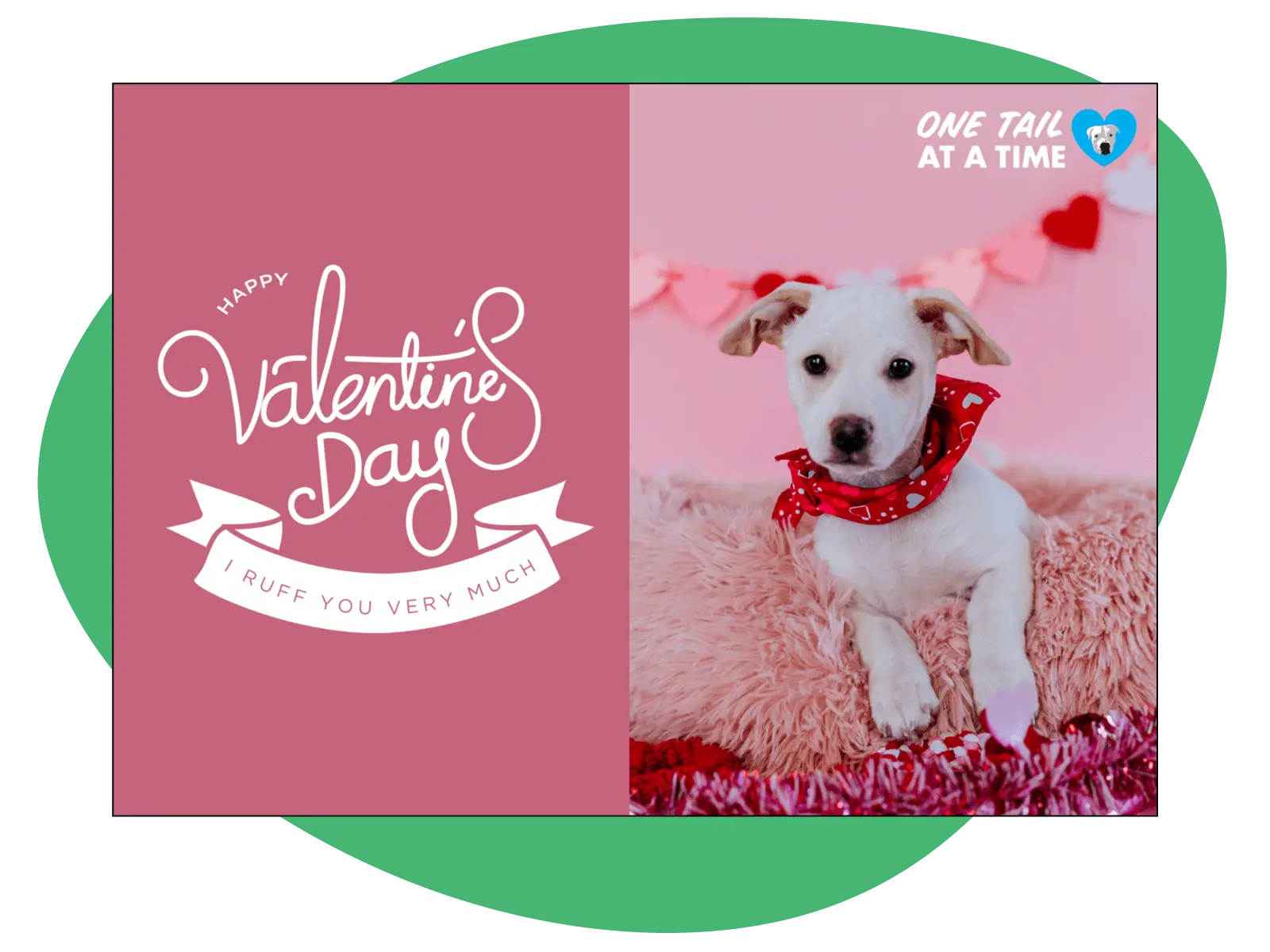
As part of the animal rescue organization’s fundraiser, donors could purchase these cute Valentine’s Day eCards featuring some of the organization’s beloved rescues. To add this channel to your fundraising strategy, follow these steps:
- Using an eCard site, create eCards branded to your cause that supporters can choose from.
- Donors select their favorite eCard, personalize it with a message, add their loved one’s contact information, and then choose a donation amount.
- The eCard is sent to the recipient, and your nonprofit receives the donation.
This approach not only provides a meaningful way to celebrate special occasions, but it also drives fundraising by linking the act of giving to the act of sending well wishes. As an innovative platform for your nonprofit’s multi-channel fundraising strategy, eCards serve the dual purpose of fostering personal connections and financially supporting philanthropic causes.
Direct Mail Fundrasing
In a world driven by technology, direct mail is a key element in your multi-channel fundraising strategy. Since it’s more personal and offers a tangible connection with donors, up to 90% of direct mail is opened while only 20-30% of emails are opened. It’s particularly effective with older demographics, and it includes various formats like personalized solicitation letters and postcards, blending detailed content with calls to action.
To integrate your fundraising channels, link your direct mail outreach to digital channels via QR codes or URLs that lead to your donation form or a campaign page. This channel’s ability to maintain donor relationships justifies higher costs associated with printing and postage, making it crucial for diverse fundraising efforts.
Website Fundraising
Think of your nonprofit’s website as the central hub of your multi-channel fundraising strategy. It simultaneously acts as a source of information and a tool for accepting donations. In the context of fundraising, your website does the following:
- Provides a comprehensive view of your organization’s mission, projects, and impact, making it a detailed resource for donors to learn about your mission.
- Showcases important fundraising initiatives, such as by promoting matching gifts with a searchable database on your donation form or a dedicated matching gifts page.
- Facilitates donations through a secure, user-friendly, and mobile-responsive donation page.
- Enables you to tell beneficiaries’ stories and post detailed reports on how you’ve used funds.
Not to mention, you can integrate your website into other channels like social media and email, driving traffic to your donation form, events pages, or other pages where visitors can learn more and potentially donate.
Your website’s role in consolidating information, providing donation opportunities, and linking various fundraising efforts makes it a cornerstone in your multi-channel fundraising approach.
Traditional Media Campaigns
Traditional media channels, such as newspapers and press releases, contribute to your multi-channel fundraising strategy by providing credibility and targeted local engagement. These channels are particularly effective for reaching demographics that may not be as active online, complementing your digital efforts.
For instance, newspapers can cover stories or events related to your work, offering valuable exposure to a local audience and strengthening your presence in your community. To help, you can distribute press releases to local media outlets to share upcoming events or fundraising campaigns.
Overall, coverage in reputable media outlets can enhance your organization’s trustworthiness, leading to increased donor confidence. By integrating traditional media into your multi-channel fundraising strategy, your organization can effectively broaden its reach within the community, maximizing the impact of your fundraising campaigns.
Phone Campaigns
Mobile users made up 33% of online donations last year, making phone calls and texts alike helpful for connecting with modern donors.
As essential components of a multi-channel fundraising strategy, phone calls and texts are direct and personalized ways to engage with donors. Here’s a breakdown of both of these fundraising channels:
- Phone calls provide a unique opportunity for meaningful, one-on-one interaction, allowing nonprofits to build deeper relationships. This personal touch is especially effective for stewardship, major gift solicitation, and situations where detailed conversations are necessary. Phone communication is often more impactful for discussing your organization’s goals and needs, answering questions, and addressing concerns potential donors have.
- Text messages, on the other hand, offer immediacy and convenience, which is particularly appealing to younger demographics. Texts can be used for quick updates, event reminders, and urgent appeals. They also provide a platform for initiating text-to-give campaigns, enabling donors to conveniently send their preferred donation amount to a dedicated phone number established by your chosen service provider.
Both phone calls and text messages can be integrated with other channels. For instance, send reminders for an upcoming event you announced on social media, ensuring a cohesive donor experience across multiple channels. Just make sure you have accurate phone numbers with a phone append first!
How to Launch a Foolproof Multi-Channel Fundraiser
Now that you have a solid understanding of the channels you can leverage to increase fundraising, it’s time to create your multi-channel fundraising strategy.
Since you’ll want to avoid a disorganized and inefficient approach, create a detailed plan that lays out your goals, prioritizes high-ROI channels, and makes the most of your budget. Put some forethought into each fundraiser’s strategy by taking the following steps:
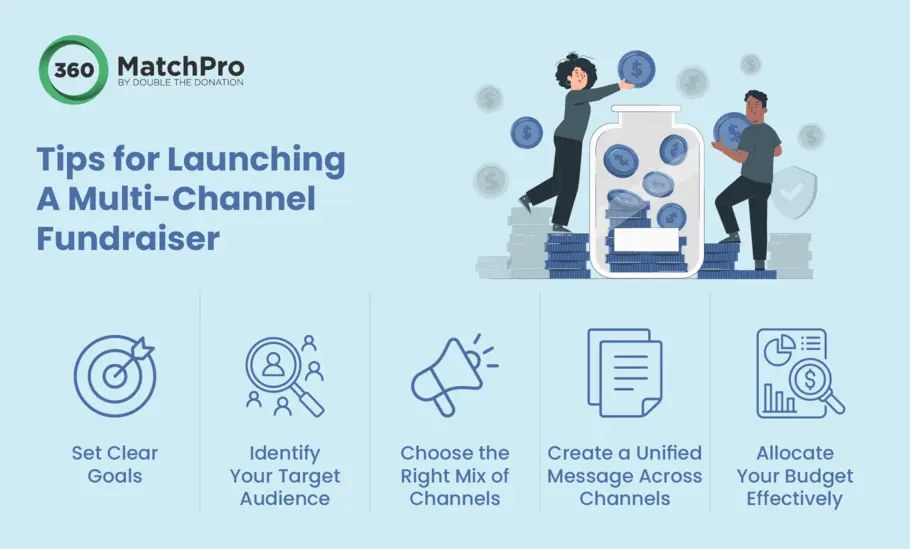
1. Set Clear Goals
Start by defining the primary purpose of your fundraising campaign. Are you aiming to raise a specific amount of money, increase donor engagement, or fund a particular project? Clear, measurable goals will guide your strategy and help evaluate its success.
To create an effective goal, develop specific, measurable, and quantifiable objectives. For example, if your goal is to raise $25,000 by the end of your campaign, set milestones and timelines for achieving that target.
2. Identify Your Target Audience
Understanding who your donors are is crucial to drive donations. Conduct a demographic analysis to identify key characteristics of current and potential donors. To make sure you’re working with accurate and complete information, conduct a demographic append, focusing on characteristics such as:
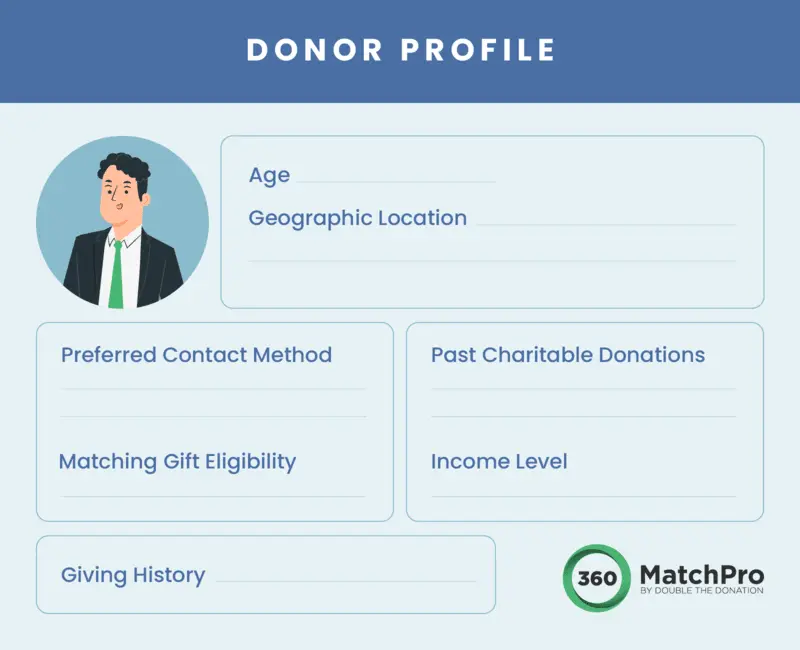
- Age so you can tailor the messaging and choice of channels to better resonate with different age groups.
- Geographic location to allow for region-specific campaigns and events, ensuring relevance and accessibility for targeted geographic communities.
- Income level to set realistic donation requests and design campaigns that align with the financial capacities of different donor groups.
- Matching gift eligibility so you can maximize fundraising potential by targeting eligible individuals to leverage employer matching programs.
- Giving history to enable personalized engagement strategies that account for past contributions.
Using this information, you can understand who receive your donation appeals. Use your CRM to segment your audience based on different commonalities so you can make each fundraising message more effective.
After all, the effectiveness of any multi-channel fundraising strategy lies in your nonprofit’s efforts to personalize and segment communication across different channels. For instance, our fundraising research indicates that personalized emails see average open rates that are 82% higher than generic emails.
3. Choose the Right Mix of Channels
From here, choose a mix of digital and traditional channels to promote your campaign. Remember not to overdo it by selecting every platform possible.
Instead, think about which channels donors tend to be most responsive on. Assess the suitability of each channel for your audience, too. For instance, younger donors might be more receptive to social media campaigns, while older demographics may prefer direct mail.
4. Create a Unified Message Across Channels
Now, craft your key message for the campaign. While the format of your message will vary by channel, branding should be consistent across all channels with similar language, tone, and visuals. While maintaining a unified message, tailor your content to fit each channel’s unique format and audience preferences.
Let’s explore an example of a fictional fundraising campaign called “Every Step Counts” for an environmental conservation organization. Here’s what unified messaging through this multi-channel fundraising campaign might look like:
- Social Media: Share visually compelling posts and stories featuring beautiful natural landscapes with brief, impactful messages about preserving the environment. Use the hashtag #EveryStepCounts to create a unified theme and encourage followers to post, too. You can also highlight stories of donors who successfully doubled their donations through matching gifts, using the campaign’s #EveryStepCounts hashtag.
- Email Newsletter: Send out a detailed newsletter to subscribers explaining the campaign, its goals, and how contributions can make a difference. Use similar imagery and language as you did on social media for consistency. Consider adding a section on matching gifts, providing a simple guide on how donors can check if their employer offers this program.
- Website: Create a dedicated campaign page with more in-depth information, donation options, and insight into progress. The page design should mirror the visual theme of the social media posts and newsletter. You can also embed your matching gift search tool to reinforce the idea of doubling donations to strengthen your campaign’s impact.
- Direct Mail: Send out physical postcards and brochures with high-quality photos of nature and a concise message echoing the digital campaign’s sentiments. You can also dedicate a portion to explaining the concept of matching gifts. Then, include a QR code linking to the campaign webpage to combine the digital and offline experiences.
In each channel, the message emphasizes the importance of individual contributions and corporate matching gifts to environmental conservation, maintaining a consistent tone and visual style that reinforces the “Every Step Counts” theme. This unified approach helps build a cohesive campaign, increasing its resonance with donors.
5. Allocate Your Budget Effectively
Finally, allocate your budget for each channel. Consider both the cost and potential return on investment (ROI) of each platform. Beyond physical materials, you’ll want to account for staff time and tools. Fundraising software and automation tools will help streamline processes and reduce manual labor needed for your multi-channel fundraising campaign.
From here, continuously monitor the performance of each channel and adjust your strategy and budget allocation accordingly. This includes scaling up successful channels and reevaluating underperforming ones. Paying attention to what resonates is crucial. After all, 61% of marketers say the most important element for a successful strategy is the accurate measurement of each channel’s performance.
Final Thoughts on Multi-Channel Fundraising
A well-executed multi-channel fundraising strategy can significantly amplify the impact of your fundraising efforts. Remember that the landscape of fundraising is constantly evolving, though. The strategies and insights shared here are just the beginning.
Remain proactive and seek out new trends, technologies, and methods to improve your approach to multi-channel fundraising. By staying open to learning, your organization can exceed its fundraising goals, making a lasting impact on your cause.
To continue learning, check out these educational resources:
- Free Nonprofit Marketing: 10 Tools to Amplify Support: Low-cost and free tools can boost your multi-channel fundraising strategy’s ROI. Explore some of the best free resources for marketing your next fundraiser.
- How to Secure Corporate Sponsorships: Find Your Perfect Fit: Corporate support is a key channel for any nonprofit’s multi-channel fundraising strategy. Learn all about this revenue source and discover how to get corporate sponsors for your cause.
- Digital Marketing for Nonprofits Made Easy: A Helpful Guide: Online marketing is an unavoidable part of multi-channel donor outreach. Discover common types and how to create a strong strategy in this guide.

